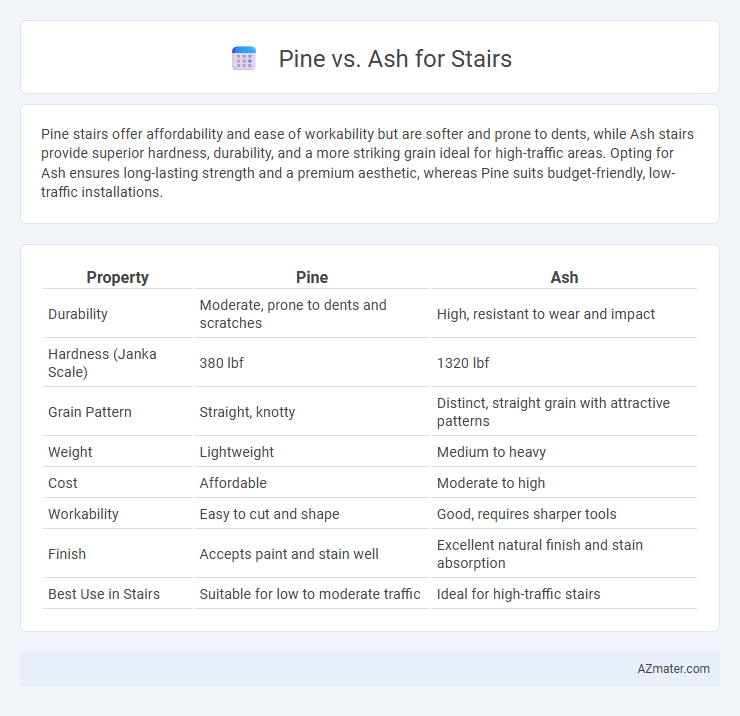Pine stairs offer affordability and ease of workability but are softer and prone to dents, while Ash stairs provide superior hardness, durability, and a more striking grain ideal for high-traffic areas. Opting for Ash ensures long-lasting strength and a premium aesthetic, whereas Pine suits budget-friendly, low-traffic installations.
Table of Comparison
| Property | Pine | Ash |
|---|---|---|
| Durability | Moderate, prone to dents and scratches | High, resistant to wear and impact |
| Hardness (Janka Scale) | 380 lbf | 1320 lbf |
| Grain Pattern | Straight, knotty | Distinct, straight grain with attractive patterns |
| Weight | Lightweight | Medium to heavy |
| Cost | Affordable | Moderate to high |
| Workability | Easy to cut and shape | Good, requires sharper tools |
| Finish | Accepts paint and stain well | Excellent natural finish and stain absorption |
| Best Use in Stairs | Suitable for low to moderate traffic | Ideal for high-traffic stairs |
Introduction to Pine and Ash Wood
Pine wood, a softwood from coniferous trees, is known for its light color, straight grain, and affordability, making it a popular choice for stair construction in residential settings. Ash, a hardwood sourced from deciduous trees, offers superior strength, durability, and a distinct grain pattern, ideal for high-traffic staircases requiring long-lasting performance. Both woods provide unique aesthetic and structural qualities, with pine favored for its cost-effectiveness and ash prized for its resilience and visual appeal.
Key Differences Between Pine and Ash
Pine stairs offer a softer wood with a lighter color and prominent knots, making them more affordable and easier to work with, but they are more prone to dents and scratches compared to ash. Ash stairs feature a harder, denser grain with a smooth texture and natural durability, providing enhanced resistance to wear and a more refined aesthetic. The key differences between pine and ash for stairs revolve around durability, grain pattern, cost, and maintenance requirements, with ash being the preferred choice for high-traffic areas due to its strength.
Durability: Pine vs Ash for Stairs
Ash wood offers superior durability for stairs due to its high density and resistance to wear, making it ideal for high-traffic areas. Pine, while more affordable and easier to work with, is softer and prone to dents and scratches, reducing its lifespan in stair applications. Choosing ash ensures long-lasting strength and minimal maintenance over time compared to pine.
Aesthetic Appeal: Grain and Color Comparison
Pine stairs exhibit a light, creamy color with a uniform grain pattern that often features subtle knots, providing a rustic and warm aesthetic ideal for traditional or country-style interiors. Ash stairs showcase a more pronounced, straight grain with a pale beige to light brown hue, delivering a sleek, contemporary look favored in modern and minimalist designs. The contrast in grain texture and color depth between pine and ash allows homeowners to choose based on desired visual impact and matching interior decor.
Cost Analysis: Pine vs Ash Stair Materials
Pine stairs typically cost less than ash due to the wood's abundance and faster growth rate, making it a budget-friendly option for cost-conscious projects. Ash, while more expensive, offers greater durability and a higher resistance to wear, which can reduce long-term maintenance costs and improve longevity. Choosing pine benefits initial savings, whereas ash provides better value over time with its strength and resilience in stair construction.
Workability and Installation Ease
Pine stairs offer superior workability due to their softwood nature, allowing for easier cutting, shaping, and nailing compared to ash. Ash, being a denser hardwood, requires more effort and specialized tools for installation but provides stronger joints and longer-lasting stair components. Pine is preferred for quicker, simpler installation, while ash is selected for durability despite more complex workability during stair construction.
Maintenance and Longevity
Pine stairs require regular sealing and are more vulnerable to dents and scratches, making maintenance more frequent compared to ash. Ash offers greater natural durability and resistance to wear, reducing the need for intensive upkeep over time. The longevity of ash stairs typically surpasses pine, lasting decades with minimal maintenance when properly finished.
Environmental Impact and Sustainability
Pine stairs offer a lower environmental impact due to their faster growth rate and renewable nature, making them a more sustainable choice compared to ash. Ash trees grow more slowly and require longer maturity periods, which can place more strain on forest ecosystems when harvested unsustainably. Choosing FSC-certified pine ensures responsible forestry practices, while ash should be sourced from well-managed forests to minimize ecological damage.
Best Applications: When to Choose Pine or Ash
Pine is ideal for staircases requiring affordability, ease of workability, and a rustic appearance, making it best suited for low-traffic or budget-conscious projects. Ash offers superior hardness, durability, and shock resistance, making it the preferred choice for high-traffic staircases or those needing long-term resilience and a refined, clear grain finish. Selecting between pine and ash depends on balancing budget constraints with durability requirements and desired aesthetic qualities for stair applications.
Conclusion: Which is Better for Your Stairs?
Ash offers superior durability and strength, making it ideal for high-traffic staircases that require long-lasting performance. Pine provides a more affordable and softer option, suitable for low-traffic areas or decorative stairs with less wear. Choosing between Ash and Pine depends on budget constraints and the desired level of hardness and longevity for your stairs.

Infographic: Pine vs Ash for Stair
 azmater.com
azmater.com